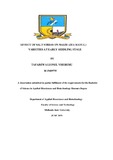Please use this identifier to cite or link to this item:
https://cris.library.msu.ac.zw//handle/11408/3725| Title: | The effect of salt stress on maize (Zea mays l.) varieties at early seedling stage | Authors: | Vheremu, Tafadzwa Lionel | Keywords: | Maize Zea mays L. Salt stress |
Issue Date: | 2019 | Publisher: | Midlands State University | Abstract: | Maize (Zea mays L.) is grown in different parts of the world, where it is a staple crop and many people rely on it as a primary source of nutrition. Salt stress is an external abiotic constraint that reduces maize ability to convert energy to biomass when it is in high concentrations. We conducted an experiment to investigate the effect of sodium chloride concentration on morphology of seedlings of maize varieties Agri Seeds R201, SC 513 and SC 403. The practical importance of the study was to develop high yielding maize varieties, which are adaptable to the salt stressed environments thereby increase in maize productivity in Zimbabwe. Maize varieties seeds were germinated in plastic pots inside the greenhouse for seven days. Different concentrations of sodium chloride, 25, 50, 75, 100% and 0% (distilled water) as a control were prepared in the laboratory. Maize seedlings were washed with distilled water before different parameters, root and shoot length, seedling height, fresh and dry weight were measured. All the data was collected and noted down for each maize seedling variety. Maize seedling roots were immersed into the saline solution with their leaves hanging out of the different plastic bottles through a circular opening on the lid for six days. The parameters, root and shoot length, seedling height, fresh and dry weight were measured after the seedlings were removed from the saline treatments. The final data was recorded by calculating the differences between the data recorded before treatment and after salt treatment. Results showed that an increase in salt concentration resulted in a decrease in root and shoot length, seedling height, fresh and dry weight of all maize varieties seedlings. Sodium chloride concentrations 25, 50, 75 and 100% had a significant mean difference when compared to the control treatment (0%) for root and shoot length, seedling height, fresh and dry weight of all maize varieties seedlings (Dunnett’s test, Multiple Comparisons). Maize seedling varieties were salt tolerant and much growth and development was favoured by sodium chloride concentration at 25%, apart from the control treatment (0%). The retardatory effects of sodium chloride on the growth of maize seedlings, require a plant breeding approach to minimize the effects of salinity, which results in the development of maize varieties that can grow and produce economic yields under saline conditions. | URI: | http://hdl.handle.net/11408/3725 |
| Appears in Collections: | Bachelor Of Science In Applied Biosciences And Biotechnology Honours Degree |
Files in This Item:
| File | Description | Size | Format | |
|---|---|---|---|---|
| TAFADZWA_L._VHEREMU_R154897W-1.pdf | Full Text | 1.02 MB | Adobe PDF |  View/Open |
Page view(s)
78
checked on Jan 14, 2025
Download(s)
48
checked on Jan 14, 2025
Google ScholarTM
Check
Items in MSUIR are protected by copyright, with all rights reserved, unless otherwise indicated.


